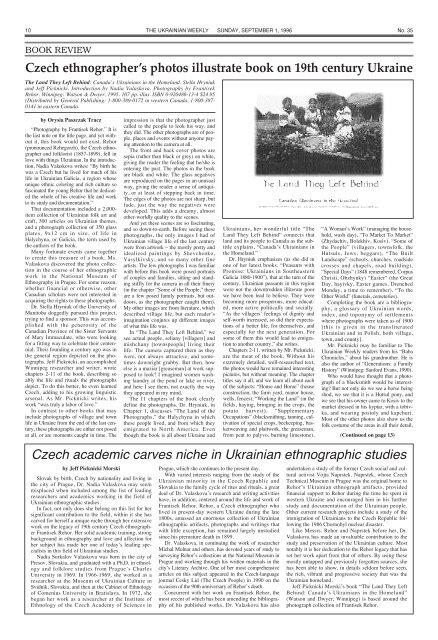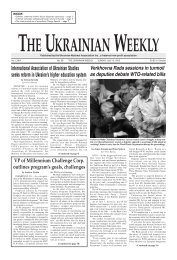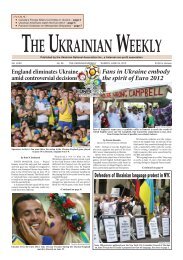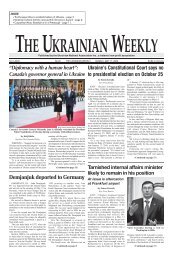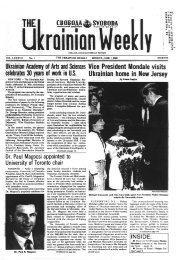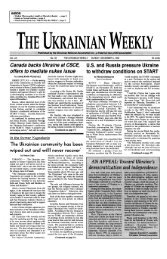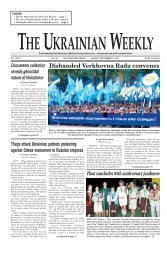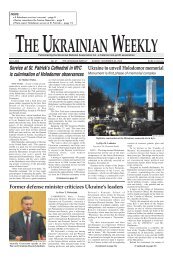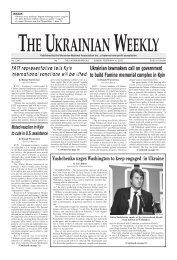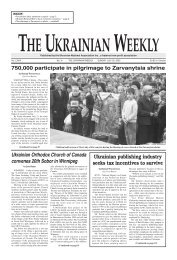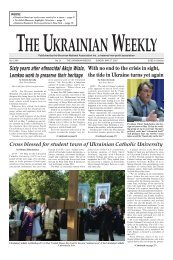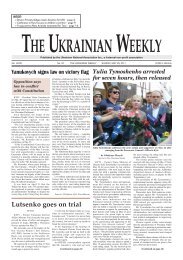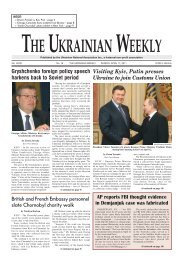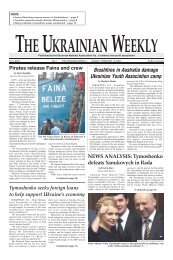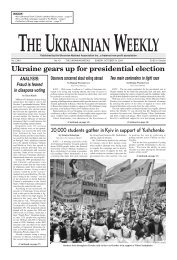Published by the Ukrainian National Association Inc
Published by the Ukrainian National Association Inc
Published by the Ukrainian National Association Inc
Create successful ePaper yourself
Turn your PDF publications into a flip-book with our unique Google optimized e-Paper software.
10 THE UKRAINIAN WEEKLY SUNDAY, SEPTEMBER 1, 1996<br />
No. 35<br />
BOOK REVIEW<br />
Czech ethnographer’s photos illustrate book on 19th century Ukraine<br />
The Land They Left Behind: Canada’s <strong>Ukrainian</strong>s in <strong>the</strong> Homeland. Stella Hryniuk<br />
and Jeff Picknicki. Introduction <strong>by</strong> Nadia Valaskova. Photography <strong>by</strong> Frantisek<br />
Rehor. Winnipeg: Watson & Dwyer, 1995. 107 pp. illus. ISBN 0-920486-13-4 $24.95<br />
(Distributed <strong>by</strong> General Publishing: 1-800-389-0172 in western Canada, 1-800-387-<br />
0141 in eastern Canada.<br />
<strong>by</strong> Orysia Paszczak Tracz<br />
“Photography <strong>by</strong> Frantisek Rehor.” It is<br />
<strong>the</strong> last note on <strong>the</strong> title page, and yet without<br />
it, this book would not exist. Rehor<br />
(pronounced Rzhegorzh), <strong>the</strong> Czech ethnographer<br />
and folklorist (1857-1899), fell in<br />
love with things <strong>Ukrainian</strong>. In <strong>the</strong> introduction,<br />
Nadia Valaskova writes: “By birth he<br />
was a Czech but he lived for much of his<br />
life in <strong>Ukrainian</strong> Galicia, a region whose<br />
unique ethnic coloring and rich culture so<br />
fascinated <strong>the</strong> young Rehor that he dedicated<br />
<strong>the</strong> whole of his creative life and work<br />
to its study and documentation.”<br />
That documentation included a 2,000-<br />
item collection of <strong>Ukrainian</strong> folk art and<br />
craft, 300 articles on <strong>Ukrainian</strong> <strong>the</strong>mes,<br />
and a photograph collection of 350 glass<br />
plates, 9x12 cm in size, of life in<br />
Halychyna, or Galicia, <strong>the</strong> term used <strong>by</strong><br />
<strong>the</strong> authors of <strong>the</strong> book.<br />
Many fortunate events came toge<strong>the</strong>r<br />
to create this treasure of a book. Ms.<br />
Valaskova discovered <strong>the</strong> photo collection<br />
in <strong>the</strong> course of her ethnographic<br />
work in <strong>the</strong> <strong>National</strong> Museum of<br />
Ethnography in Prague. For some reason,<br />
whe<strong>the</strong>r financial or o<strong>the</strong>rwise, o<strong>the</strong>r<br />
Canadian scholars were not interested in<br />
acquiring <strong>the</strong> rights to <strong>the</strong>se photographs.<br />
Dr. Stella Hryniuk of <strong>the</strong> University of<br />
Manitoba doggedly pursued this project,<br />
trying to find a sponsor. This was accomplished<br />
with <strong>the</strong> generosity of <strong>the</strong><br />
Canadian Province of <strong>the</strong> Sister Servants<br />
of Mary Immaculate, who were looking<br />
for a fitting way to celebrate <strong>the</strong>ir centennial:<br />
Their founding a century ago was in<br />
<strong>the</strong> general region depicted on <strong>the</strong> photographs.<br />
Jeff Picknicki, an accomplished<br />
Winnipeg researcher and writer, wrote<br />
chapters 2-11 of <strong>the</strong> book, describing so<br />
ably <strong>the</strong> life and rituals <strong>the</strong> photographs<br />
depict. To do this better, he even learned<br />
Czech, adding to his growing linguistic<br />
arsenal. As Mr. Picknicki writes, his<br />
work “was truly a labor of love.”<br />
In contrast to o<strong>the</strong>r books that may<br />
include photographs of village and town<br />
life in Ukraine from <strong>the</strong> end of <strong>the</strong> last century,<br />
<strong>the</strong>se photographs are ei<strong>the</strong>r not posed<br />
at all, or are moments caught in time. The<br />
impression is that <strong>the</strong> photographer just<br />
called to <strong>the</strong> people to look his way, and<br />
<strong>the</strong>y did. The o<strong>the</strong>r photographs are of people,<br />
places and events without anyone paying<br />
attention to <strong>the</strong> camera at all.<br />
The front and back cover photos are<br />
sepia (ra<strong>the</strong>r than black or grey) on white,<br />
giving <strong>the</strong> reader <strong>the</strong> feeling that he/she is<br />
entering <strong>the</strong> past. The photos in <strong>the</strong> book<br />
are black and white. The glass negatives<br />
are reproduced on <strong>the</strong> pages in an unusual<br />
way, giving <strong>the</strong> reader a sense of antiquity,<br />
or at least of stepping back in time.<br />
The edges of <strong>the</strong> photos are not sharp, but<br />
fade, just <strong>the</strong> way <strong>the</strong> negatives were<br />
developed. This adds a dreamy, almost<br />
o<strong>the</strong>r-worldly quality to <strong>the</strong> scenes.<br />
And yet <strong>the</strong>se scenes are so fascinating,<br />
and so down-to-earth. Before seeing <strong>the</strong>se<br />
photographs, <strong>the</strong> only images I had of<br />
<strong>Ukrainian</strong> village life of <strong>the</strong> last century<br />
were from artwork – <strong>the</strong> mostly pretty and<br />
idealized paintings <strong>by</strong> Shevchenko,<br />
Vasylkivsky, and so many o<strong>the</strong>r fine<br />
artists. The few photographs I was familiar<br />
with before this book were posed portraits<br />
of couples and families, sitting and standing<br />
stiffly for <strong>the</strong> camera in all <strong>the</strong>ir finery<br />
(in <strong>the</strong> chapter “Some of <strong>the</strong> People,” <strong>the</strong>re<br />
are a few posed family portraits, but outdoors,<br />
as <strong>the</strong> photographer caught <strong>the</strong>m).<br />
My o<strong>the</strong>r images are from literature, which<br />
described village life, but each reader’s<br />
imagination conjures up different images<br />
of what this life was.<br />
In “The Land They Left Behind,” we<br />
see actual people, seliany [villagers] and<br />
mishchany [townspeople] living <strong>the</strong>ir<br />
life. The camera captured <strong>the</strong>m as <strong>the</strong>y<br />
were, not always attractive, and sometimes<br />
downright grub<strong>by</strong>. But <strong>the</strong>n, how<br />
else is a maziar [greaseman] at work supposed<br />
to look? I imagined women washing<br />
laundry at <strong>the</strong> pond or lake or river,<br />
and here I see <strong>the</strong>m, not exactly <strong>the</strong> way<br />
<strong>the</strong>y appeared in my mind.<br />
The 11 chapters of <strong>the</strong> book clearly<br />
define <strong>the</strong> photographs. Dr. Hryniuk, in<br />
Chapter 1, discusses “The Land of <strong>the</strong><br />
Photographs,” <strong>the</strong> Halychyna in which<br />
<strong>the</strong>se people lived, and from which <strong>the</strong>y<br />
emigrated to North America. Even<br />
though <strong>the</strong> book is all about Ukraine and<br />
<strong>Ukrainian</strong>s, her wonderful title “The<br />
Land They Left Behind” connects that<br />
land and its people to Canada as <strong>the</strong> subtitle<br />
explains, “Canada’s <strong>Ukrainian</strong>s in<br />
<strong>the</strong> Homeland.”<br />
Dr. Hryniuk emphasizes (as she did in<br />
one of her latest books, “Peasants with<br />
Promise: <strong>Ukrainian</strong>s in Sou<strong>the</strong>astern<br />
Galicia 1880-1900”), that at <strong>the</strong> turn of <strong>the</strong><br />
century, <strong>Ukrainian</strong> peasants in this region<br />
were not <strong>the</strong> downtrodden illiterate poor<br />
we have been lead to believe. They were<br />
becoming more prosperous, more educated,<br />
more active politically and socially.<br />
“As <strong>the</strong> villagers’ feelings of dignity and<br />
self-worth increased, so did <strong>the</strong>ir expectations<br />
of a better life, for <strong>the</strong>mselves, and<br />
especially for <strong>the</strong> next generation. For<br />
some of <strong>the</strong>m this would lead to emigration<br />
to ano<strong>the</strong>r country,” she writes.<br />
Chapters 2-11, written <strong>by</strong> Mr. Picknicki,<br />
are <strong>the</strong> meat of <strong>the</strong> book. Without his<br />
extremely detailed, well-researched text,<br />
<strong>the</strong> photos would have remained interesting<br />
pictures, but without meaning. The chapter<br />
titles say it all, and we learn all about each<br />
of <strong>the</strong> subjects: “House and Home” (house<br />
construction, <strong>the</strong> farm yard, manor house,<br />
wells, fences), “Working <strong>the</strong> Land” (in <strong>the</strong><br />
fields, haying, bringing in <strong>the</strong> crops, <strong>the</strong><br />
potato harvest), “Supplementary<br />
Occupations” (blacksmithing, tanning, cultivation<br />
of special crops, beekeeping, basketweaving<br />
and plaitwork, <strong>the</strong> greaseman,<br />
from peat to palyvo, burning limestone),<br />
“A Woman’s Work” (managing <strong>the</strong> household,<br />
wash day), “To Market To Market”<br />
(Zhydachiv, Bolekhiv, Kosiv), “Some of<br />
<strong>the</strong> People” (villagers, townsfolk, <strong>the</strong><br />
Hutsuls, Jews, beggars), “The Built<br />
Landscape” (schools, churches, roadside<br />
crosses and chapels, road building),<br />
“Special Days” (1848 remembered, Corpus<br />
Christi, Obzhynky) “Easter” (<strong>the</strong> Great<br />
Day, hayivky, Easter games, Drenched<br />
Monday, a time to remember), “To <strong>the</strong><br />
O<strong>the</strong>r World” (funerals, cemeteries).<br />
Completing <strong>the</strong> book are a bibliography,<br />
a glossary of <strong>Ukrainian</strong> words,<br />
index, and toponymy of settlements<br />
where photographs were taken as of 1900<br />
[this is given in <strong>the</strong> transliterated<br />
<strong>Ukrainian</strong> and in Polish, both village,<br />
town, and county].<br />
Mr. Picknicki may be familiar to The<br />
<strong>Ukrainian</strong> Weekly readers from his “Baba<br />
Chronicles,” about his grandmo<strong>the</strong>r. He is<br />
also <strong>the</strong> author of “Generations: a Family<br />
History” (Winnipeg: Sanford Evans, 1990).<br />
Who would have thought that a photograph<br />
of a blacksmith would be interesting?<br />
But not only do we see a horse being<br />
shod, we see that it is a Hutsul pony, and<br />
we see that his owner came to Kosiv to <strong>the</strong><br />
market dressed in his kyptar, with a tobivka,<br />
and wearing postoly and kapchuri.<br />
Most of <strong>the</strong> o<strong>the</strong>r photos also show us <strong>the</strong><br />
folk costume of <strong>the</strong> areas in all <strong>the</strong>ir detail,<br />
(Continued on page 13)<br />
Czech academic carves niche in <strong>Ukrainian</strong> ethnographic studies<br />
<strong>by</strong> Jeff Picknicki Morski<br />
Slovak <strong>by</strong> birth, Czech <strong>by</strong> nationality and living in<br />
<strong>the</strong> city of Prague, Dr. Nadia Valaskova may seem<br />
misplaced when included among <strong>the</strong> list of leading<br />
researchers and academics working in <strong>the</strong> field of<br />
<strong>Ukrainian</strong> ethnographic studies.<br />
In fact, not only does she belong on this list for her<br />
significant contribution to <strong>the</strong> field, within it she has<br />
carved for herself a unique niche through her extensive<br />
work on <strong>the</strong> legacy of 19th century Czech ethnographer<br />
Frantisek Rehor. Her solid academic training, strong<br />
background in ethnography and love and affection for<br />
her subject has made her one of today’s leading specialists<br />
in this field of <strong>Ukrainian</strong> studies.<br />
Nadia Surkalov Valaskova was born in <strong>the</strong> city of<br />
Presov, Slovakia, and graduated with a Ph.D. in ethnology<br />
and folklore studies from Prague’s Charles<br />
University in 1969. In 1966-1969, she worked as a<br />
researcher at <strong>the</strong> Museum of <strong>Ukrainian</strong> Culture in<br />
Svidnik, Slovakia, and <strong>the</strong>n at <strong>the</strong> Cabinet of Ethnology<br />
of Comenius University in Bratislava. In 1972, she<br />
began her work as a researcher at <strong>the</strong> Institute of<br />
Ethnology of <strong>the</strong> Czech Academy of Sciences in<br />
Prague, which she continues to <strong>the</strong> present day.<br />
With varied interests ranging from <strong>the</strong> study of <strong>the</strong><br />
<strong>Ukrainian</strong> minority in <strong>the</strong> Czech Republic and<br />
Slovakia to <strong>the</strong> family cycle of rites and rituals, a great<br />
deal of Dr. Valaskova’s research and writing activities<br />
have, in addition, centered around <strong>the</strong> life and work of<br />
Frantisek Rehor. Rehor, a Czech ethnographer who<br />
lived in present-day western Ukraine during <strong>the</strong> late<br />
1800s, amassed an enormous collection of <strong>Ukrainian</strong><br />
ethnographic artifacts, photographs and writings that<br />
with little exception, has remained largely unstudied<br />
since his premature death in 1899.<br />
Dr. Valaskova, in continuing <strong>the</strong> work of researcher<br />
Michal Molnar and o<strong>the</strong>rs, has devoted years of study to<br />
surveying Rehor’s collections at <strong>the</strong> <strong>National</strong> Museum in<br />
Prague and working through his written materials in <strong>the</strong><br />
city’s Literary Archive. One of her most comprehensive<br />
articles on this subject appeared in <strong>the</strong> Czech-language<br />
journal Cesky Lid (The Czech People) in 1990 on <strong>the</strong><br />
occasion of <strong>the</strong> 90th anniversary of Rehor’s death.<br />
Concurrent with her work on Frantisek Rehor, <strong>the</strong><br />
most recent of which has been amending <strong>the</strong> bibliography<br />
of his published works, Dr. Valaskova has also<br />
undertaken a study of <strong>the</strong> former Czech social and cultural<br />
activist Vojta Naprstek. Naprstek, whose Czech<br />
Technical Museum in Prague was <strong>the</strong> original home to<br />
Rehor’s <strong>Ukrainian</strong> ethnograph artifacts, provided<br />
financial support to Rehor during <strong>the</strong> time he spent in<br />
western Ukraine and encouraged him in his fur<strong>the</strong>r<br />
study and documentation of <strong>the</strong> <strong>Ukrainian</strong> people.<br />
O<strong>the</strong>r current research projects include a study of <strong>the</strong><br />
immigration of <strong>Ukrainian</strong>s to <strong>the</strong> Czech Republic following<br />
<strong>the</strong> 1986 Chorno<strong>by</strong>l nuclear disaster.<br />
Like Messrs. Rehor and Naprstek before her, Dr.<br />
Valaskova has made an invaluable contribution to <strong>the</strong><br />
study and preservation of <strong>the</strong> <strong>Ukrainian</strong> culture. Most<br />
notably it is her dedication to <strong>the</strong> Rehor legacy that has<br />
set her work apart from that of o<strong>the</strong>rs. By using <strong>the</strong>se<br />
mostly untapped and previously forgotten sources, she<br />
has been able to show, in details seldom before seen,<br />
<strong>the</strong> rich, vibrant and progressive society that was <strong>the</strong><br />
<strong>Ukrainian</strong> homeland.<br />
Jeff Picknicki Morski’s book “The Land They Left<br />
Behind: Canada’s <strong>Ukrainian</strong>s in <strong>the</strong> Homeland”<br />
(Watson and Dwyer, Winnipeg) is based around <strong>the</strong><br />
photograph collection of Frantisek Rehor.


